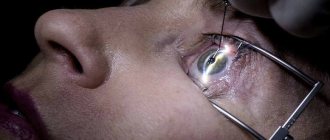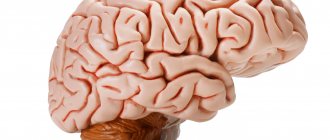Signs and symptoms of locked-in syndrome
People with Locked In syndrome are classically unable to consciously or voluntarily chew, swallow, breathe, speak, or make any movements other than those involving the eyes or eyelids. Some patients can move their eyes up and down (vertically), but not side to side (horizontally).
Individuals with lock-in syndrome are fully alert and aware of their surroundings. They can hear, see, and maintain sleep-wake cycles. Affected individuals may communicate through targeted eye movements or blinking, or both. They can understand people speaking or reading to them.
People with Locked In syndrome often start out in a comatose state and then gradually regain consciousness but remain paralyzed and unable to speak.
People in pseudocoma (the second name for the disorder) are usually unable to consciously chew, swallow, breathe, speak, or move. The ability to move is retained only in the eyelids and eyeballs, as a result of which patients can make vertical eye movements. At the same time, movements in the horizontal plane (from side to side, not up and down) remain impossible.
Patients diagnosed with locked-in syndrome are fully aware of everything that is happening around them. They can see and hear and maintain the body's normal sleep-wake cycles. Communication is possible through eye movements or blinking; Both gestures are often used. People in a pseudocoma perfectly understand the meaning of everything they are told or read.
Most often, victims are initially in a coma. Then consciousness gradually returns to them, but the patients remain paralyzed and incapable of active life.
Symptoms of the disorder
Locked-in syndrome manifests itself in a decrease in the motor activity of the limbs up to their complete paralysis (with preservation of muscle tone) and pseudobulbar syndrome due to which bulbar functions disappear (swallowing, facial expressions, speech, articulation, chewing). These are the most basic manifestations of this pathology.
The patient's condition is close to coma, since the ability to breathe, speak, chew and swallow food is often lost. The person is immobilized, but his skin sensitivity is preserved. This condition is also called a waking coma, since it manifests itself as total immobility while maintaining the movements of the eyeballs and blinking.
A person’s connection with the world is carried out through the eyes in the vertical plane (eye movement in another direction is not noted).
Some patients can move their eyelids and can close and open their eyes. Brain functions are not affected by isolation syndrome because the sleep-wake cycle is maintained. While in a state of wakefulness, the patient hears and is aware of what is happening around him, but his reactions are inside his body and hidden from prying eyes.
This syndrome can occur against the background of progression of one of the pathologies described above. A person falls into a coma for some time, and upon emerging from the coma, he loses the ability to communicate and can blink his eyes, while losing the ability to care for himself.
Often this syndrome develops gradually. The motor activity of the legs and arms slows down, then difficulties with breathing and pronouncing sounds appear, and the ability to concentrate the gaze on a specific object disappears. The person no longer returns to normal life, remaining motionless in bed.
Clinical forms of the “locked-in person” syndrome
Locked In syndrome can be classified into three different clinical forms, according to the traditional Bauer classification. This classification is based on the amount of motor output that is retained in patients.
The pure form of the syndrome is diagnosed when the patient loses control of all body movements, with the exception of blinking and vertical eye movements; incomplete form, when some voluntary movements other than eye movements are preserved, and complete form, when there is complete loss of motor function.
Diagnostics
Since a neurologist can independently determine locked-in syndrome with great accuracy, diagnosis is often carried out in a clinical setting. To differentiate the pathology from a number of other disorders with similar symptoms, special studies are carried out. Thus, MRI is considered mandatory - magnetic resonance imaging, which can clearly show damage to the pons, and magnetic resonance angiography - the optimal way to detect blood clots in the arteries of the brain stem. In addition, these studies contribute to the detection of other brain injuries.
An electroencephalogram, a method of measuring electrical activity in the brain, can provide evidence of normal brain activity and maintenance of sleep-wake cycles in patients diagnosed with locked-in syndrome.
What is modern medicine capable of?
It would seem that it is virtually impossible to cure such a disease; its negative effects are too powerful. But in fact, scientists are trying to get out of this situation, and in some cases they have already achieved considerable success.
The main goal of treating the syndrome is, if not complete recovery, then maintaining a person’s life and eliminating dangerous symptoms.
It’s worth saying right away that due to the current insufficient level of development of medicine and the great severity of the disease, the majority of patients with isolation syndrome still die, which happens within approximately one month from the date of the onset of the active phase of the disease.
One hundred percent mortality is observed if the syndrome arose as a consequence of another incurable disease (for example, ALS). But in cases where the original cause was something that can be dealt with, cases of even complete recovery are possible, although they are extremely rare.
Treatment for locked-in syndrome consists of the following steps:
- Providing high-quality nutrition rich in essential substances. If the patient has lost the ability to chew and swallow, special methods of feeding the person are used. It is very important what he is given to eat and how balanced the diet is.
- High level of hygiene maintenance . Since the patient cannot move independently, he does not have the opportunity to go to the toilet or change his underwear on time. Other people have to do this, and the patient’s condition will depend on how responsibly this happens.
- It is important to carry out therapy and treatment of the underlying disease that caused the syndrome. This is the only way to get a person back on his feet.
Naturally, medications play a leading role in treatment.
More often than others they use:
- drugs from the glucocorticoid class;
- Antihistamines such as Diphenhydramine or Suprastin are widely used;
- plasmapheresis is used - this is a special method of therapy based on the injection of immunoglobulin into the patient’s veins;
A very important part of treatment is constant monitoring of the patient's ability to breathe. Respiratory failure appears very quickly and you need to be ready to eliminate it at any time.
Quality of life of people with Locked In syndrome
Although locked-in syndrome is the most dramatic form of motor disability imaginable, some scientific reports show that patients' quality of life is not as poor as expected. A recent study examined the quality of life of chronic patients with isolation syndrome and concluded that many patients live meaningful lives, especially when appropriate social services help patients play a normal role at home and in the family.
Forms of the syndrome
Locked-in syndrome occurs differently for everyone. The general symptom is the preservation of the electrical activity of the brain and cognitive abilities against the background of a complete decrease in movements of the limbs, facial and articulatory muscles.
These symptoms are inherent in the classic type of locked-in syndrome, due to dysfunction of the brain stem structures.
If a person experiences movements of the eyelids and eyeballs, as well as some muscle groups, then this is an incomplete isolation syndrome, namely a mild form of the described disease, which gives more opportunities to overcome the disease.
The total form of the syndrome is marked by the absence of all motor reactions when the brain is working (this is shown by the results of the encephalogram). This severe form is often confused with coma.
Locked-in syndrome changes the life of the sufferer forever. The body is able to function thanks to special care and artificial respiration devices. Feeding patients is possible through a tube.
A person’s life depends entirely on the care of relatives and their patience. A bedridden patient is in dire need of preventive measures to prevent the formation of bedsores. The person needs to be turned over regularly.
Treatment
Closedness, which impedes a person’s socialization and reduces the quality of life, requires correction. In severe mental illnesses, restoration of communicative function is possible only with complex treatment, including drug therapy, psychotherapy, and rehabilitation. If communication difficulties are associated with characterological disorders or psychological problems, symptomatic help, represented by individual psychotherapy, group trainings, and targeted creation of conditions that require maintaining a conversation, has a good effect.
Additional symptoms
Patients with Locked In syndrome are traditionally considered to be cognitively intact because all cerebral structures, with the exception of the ventral part of the brain, appear to be spared. However, recent evidence suggests that patients may develop some non-motor symptoms, including motor imagery defects, pathological laughing and crying, and difficulty recognizing certain facial expressions.
Interruption of the corticopontocerebellar pathways by the same lesion causing isolation syndrome may be responsible for these clinical manifestations. However, these symptoms were not found in all victims and are currently under further investigation. Recognition of motor image defects deserves special attention because these symptoms, when present, can interfere with the success of rehabilitation strategies.
Portrait of a patient with victim syndrome
Since the pathology is manifested by a whole complex of different signs, it is possible to draw up a general portrait of a patient with victim syndrome. For such a patient it is typical:
Depressed mood. People with the syndrome are absolute pessimists. They always notice only the bad and are sure that even their relatives want to offend or set them up. Therefore, they have practically no reason to rejoice. Egocentrism. For patients there is no other correct opinion than their own. And if someone tries to convince them, they will only receive a storm of indignation and hysterics in response. Not accepting your own failures. This phenomenon can also occur in the lives of absolutely healthy people. In case of disorder, the situation repeats itself much more often. At the same time, the patient completely refuses to admit guilt and, on the contrary, only looks for those to blame. But he is unable to express an opinion because of his own timidity and shyness. Joy in other people. People with the syndrome react especially vividly to the happiness of colleagues, friends or even relatives. And it’s impossible not to notice. Patients complain of a lack of luck and luck in themselves and, as a result, are very upset by the success of others. Need for increased authority
It is important for patients to regularly feel like a significant and important person both at work and in the family. Their every action and decision requires approval and encouragement.
If this does not happen for a long enough time, then the patient develops an inferiority complex. Frequent complaints. People with victim syndrome love to talk, or rather, complain. All events that happen in their lives necessarily have negative consequences. And it is almost impossible to convince patients. Avoidance of responsibility. This symptom can be noticed already in early childhood, when the child does not admit to what he has done and shifts his blame. But if in youth such behavior can still be considered a manifestation of immaturity, then in adults it is a clear sign of victim syndrome. For example, when a person refuses a promotion at work in order to avoid certain obligations. Attempts to evoke pity. At first glance, this sign is not special, because any person would be happy, for example, with the help of loved ones and their care during a cold. But in patients with the syndrome, the need for support is constantly present. Every minute they are ready to talk about any difficult moments of their life, but at the same time they are unable to listen to their interlocutor at least once and help him. Expecting only negative results. Patients like to exaggerate the consequences of their actions. They believe that any situation will definitely have an exclusively negative ending. This symptom manifests itself especially strongly when the victim commits some not very good deed. Excessive independence. Patients with the syndrome can easily help their friends and relatives, but will be categorically against retaliatory actions. It is important for them to feel unhappy, and this is only possible when there is a negative situation. From the outside, this behavior looks like stubborn and stupid persistence. Inability to refuse. People with victim syndrome usually cannot refuse others. Therefore, any request, even the most humiliating for the patient, will certainly be fulfilled. This occurs due to the patient’s fear of remaining alone and unnecessary to anyone at all.
All these signs are common to patients with the disorder. But do not forget that each person is individual, so the manifestations of the disease may vary.
What is the benefit for the victim?
Psychologists and psychiatrists have long come to the conclusion that patients with victim syndrome are excellent manipulators. With their complaints and negative attitude towards everything that happens in life, they easily overcome their goals and achieve unprecedented heights. Moreover, their numerous failures and problems can serve as a good excuse in any situation. And shifting one’s own obligations onto other people is also a fairly thoughtful and convenient move.
Contact
there is no cure for this condition, although in some cases people become able to gradually contract their facial muscles over time. Modern technologies are developing very quickly - it is quite possible that scientists will soon invent a computerized method of communicating with people who have fallen into a pseudocoma.
Since computerization has not yet achieved such progress, each individual case should develop its own system for contacting the patient. It is recommended to start with the simplest encoding: for example, a look up will mean approval or agreement, a look down will mean disagreement or denial.
Can people in a vegetative state hear and understand speech?
Often, relatives of people who find themselves in this condition convince doctors that their loved one is giving signs: slightly moving his fingers or smiling. Unfortunately, many people just want to believe and hope for the best. But among the patients there are also those who are truly aware of what is happening around them.
Previously, it was believed that if a person remained in a vegetative state for more than twelve months, then returning to consciousness was practically impossible. Now doctors have been able to make progress in this matter and have learned to improve the mental activity of a person in a vegetative state. For example, using electrical stimulation.










